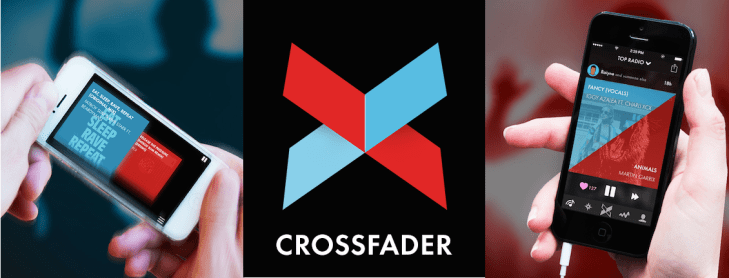No Pro Tools, no record players, no DJ skills required. With Crossfader, you just swipe between songs, pick two you like, and tilt back and forth to mix them into a mashup. This is Turntable.FM co-founder Seth Goldstein’s plot to turn legions of young ravers into creators.
The iOS app was built by Goldstein’s DJZ team, which is pivoting from a dance music news site into a Crossfader social hub that houses what happens when you combine Tiesto and Miley Cyrus or Diplo and Missy Elliot. This week Crossfader released a radio feature, so you can rock a party yourself or just play others’ sonic Frankenstein’s monsters, both on mobile and the web.
“How do you build a global remix community?” Goldstein asks. “First we had to build the instrument.”
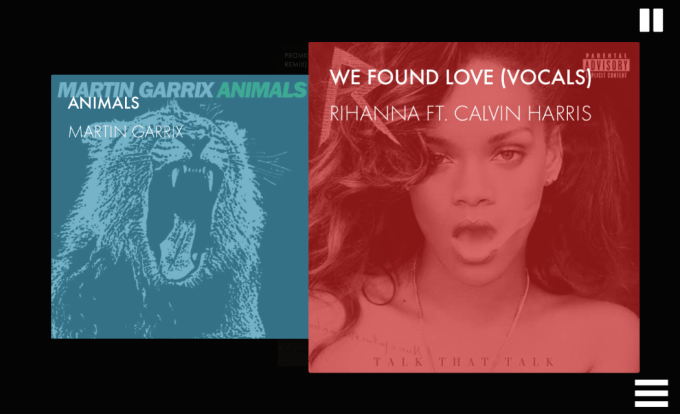
Thanks to its use of the iPhone’s accelerometers, that’s how Crossfader feels. Like it’s alive in your hands rather than an app you’re interfacing with.
To make a mix, you flick through regularly updated “packs” of the best snippets of songs, like the drums and hook of a Skrillex jam or the lyrics of one by Dr. Dre. Pick one on each side of the screen and they both play at the same time.
Crossfader syncs the two songs’ timing, tempo, and key so they always sound good together. Keep your phone steady to hear them balanced in the mix, or tilt left or right to fade from one across to the other in real time. You might accentuate the vocals as the hook revs up, then tilt over to the beat as the drop hits with a wall of bass. Then you can lean Crossfader toward you/up to kill the bass and leave the anticipation-inducing high end audible. Then tilt the phone forward/down to filter out the high end and just get the deep, low frequencies like you’re dancing underwater.
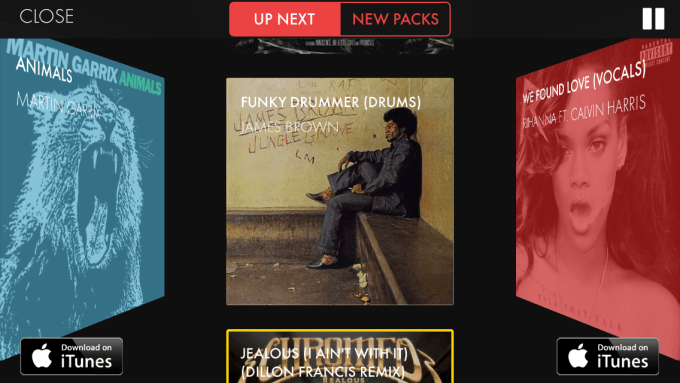
Tire of either song and you can swap it out on the fly and Crossfader will make the transition happen smooth and on the beat. “This is about taste, not technique,” says Goldstein, explaining that a good ear for what sounds right matters more than the hand-eye coordination DJs need on traditional equipment.
That’s not exactly true, though. Get jostled or forget what you’re doing and you might whiplash your audience by accidentally switching from one sample to the other. A steady hand is important unless you want to sound scatter-brained. If you want a more professional tool, Djay, Traktor and Pacemaker are better choices.
![]() Beyond the instrument side of the app, you can customize a DJ profile avatar for yourself. If you find a pair of songs that sound awesome and you can lock them together as a Crossfade, save it to your profile, and share in the app’s feed where other people can re-remix it, or out to Facebook and Twitter where they’ll play in-line.
Beyond the instrument side of the app, you can customize a DJ profile avatar for yourself. If you find a pair of songs that sound awesome and you can lock them together as a Crossfade, save it to your profile, and share in the app’s feed where other people can re-remix it, or out to Facebook and Twitter where they’ll play in-line.
Your creations could also end up on what was DJZ but is becoming a Crossfader content site. “DJZ goes away as a top-down editorial property and becomes a bottom-up remix community,” Goldstein explains.
See, Goldstein’s last big startup Turntable.fm imploded in late 2013. It started back in 2011 as a site where anyone could DJ live over the web for the friends and strangers who were represented as little head-bobbing avatars in a virtual club. But Turntable fell into the chasm between being a passive radio site you’d listen to in the background and an active music-themed chat room. It didn’t stick and royalties were piling up, so it shut down.
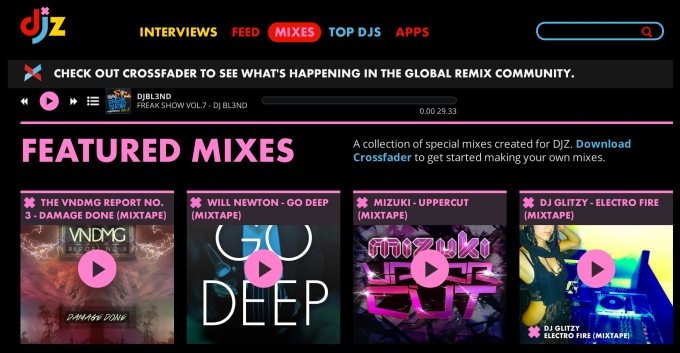
By then, Goldstein had already raised $1 million from Google Ventures, Kleiner Perkins, Index Ventures, Zynga’s Mark Pincus, and former Lady Gaga manager Troy Carter to make DJZ, a news hub for the electronic dance music scene that was blowing up. But it turns out the kids just want to dance, not read, so Goldstein began developing DJZ/U, an interactive tutorial app that would teach users to DJ. But the team realized that rather than teaching the complexities of DJing, they should just make the art simpler. DJZ pivoted to build Crossfader with another $2 million in funding from Shawn Gruver and Telegraph Hill Capital, and big-name DJs like Diplo and Atrak are advisers.
To succeed as a passive app where Turntable failed, Crossfader this week launched a radio feature. If enough people dig your mashup, it’ll wind up in Crossfader’s “Top Radio,” which automatically plays and smoothly transitions between the best remixes. You can also listen to a curated “Featured Radio” or discover “Fresh” song combos. Crossfader Radio means you can sit back and listen on web or mobile if you’re too lazy or busy to recombinate your own jams.
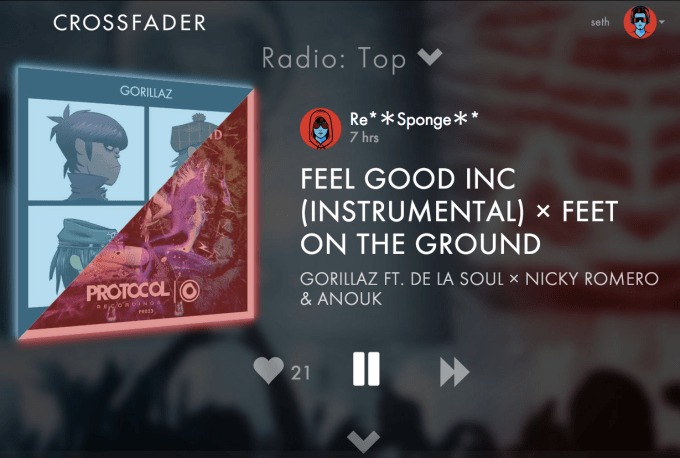
And the whole thing is free. Each song clip in the app is just 30 seconds long, so it’s considered a “preview.” Tap through and you can buy the songs on iTunes. Whether this is perfectly legal is debatable. The length doesn’t determine if something is fair use. If the record labels view Crossfader as useful promotion that doesn’t cannibalize sales, they may allow it. But if they think people are listening to it instead of streaming or buying music where they earn royalties, Goldstein may be in for some legal trouble.
He admits that Crossfader is in a gray area but says he feels good about their position as long it has short loops and buy buttons and doesn’t let you record. “All that being said, this is still an evolving space and so we will continue to work with rights holders to ensure that they feel like what we are doing drives discovery and promotion of their music, and over time drives monetization as well.”
Crossfader hopes to make some money for itself too by selling premium sonic effects like flanger, which gives songs that robotic ‘shhheeeaaaaarrrroooooooooooo’ sound.
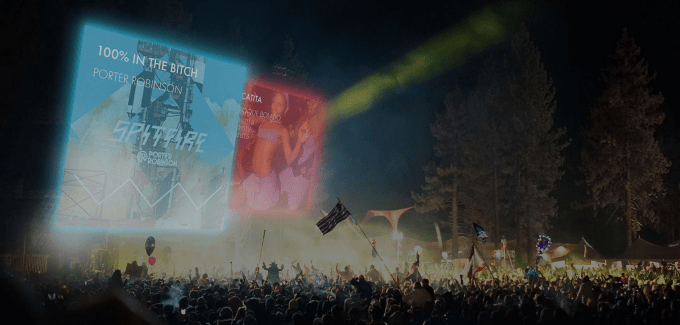
In the end, Crossfader is fun to play with, but the question will be whether it’s useful to keep digital disc jockeys coming back. Music-listening apps like Spotify could always integrate better DJing features, and they already have trouble finding consistent users. Traction for a music-creation app will be even tougher, though it is magnitudes simpler than its peers.
“Instagram took 5 percent of the functionality of Photoshop and made it relevant to hundreds of millions of people,” Goldstein says. “There’s a bunch of apps out there like djay with the classic two turntable model, and we’re clearly not doing that. We seized on this idea of the crossfader as the minimal gesture of DJing.”
